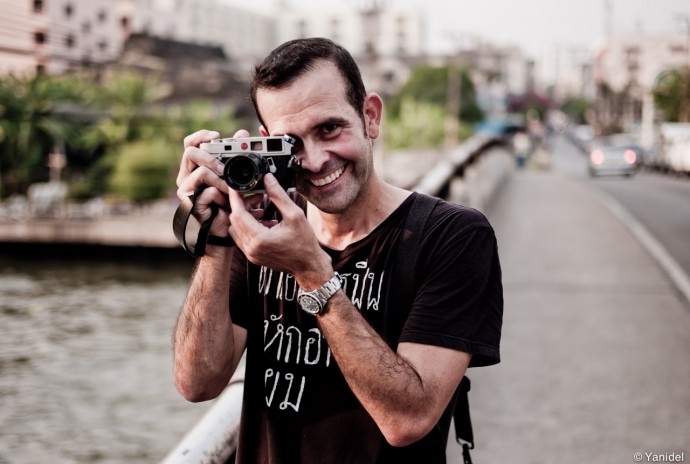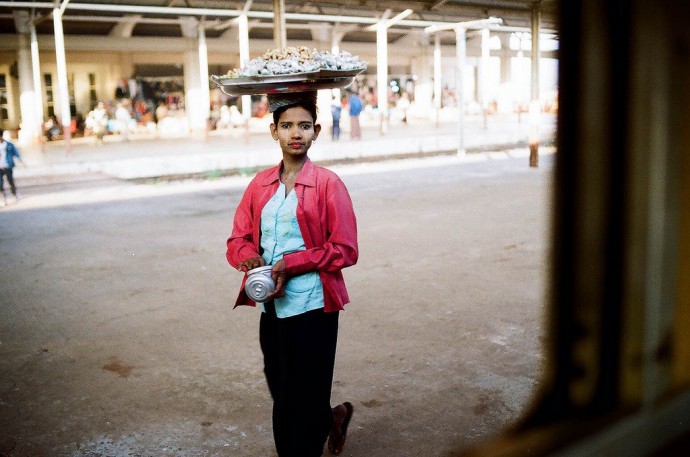We met Michael Bialecki while spending two weeks in Bangkok (introduced by our friend Kristian Dowling). And we owe him so much. Michael has been great to us as he took us all around town, to restaurants, to camera stores and even to the city’s red light district. He is also a big part of the reason we went to Myanmar. His pictures and stories made the craving so big that we re-routed our trip.
Michael is also a tremendously talented photographer. Seeing him work in the street was a pleasure; jumping around, interacting with people and with a “go get the shot” attitude. He shoots film (Leica M6 with 35mm Nokton 1.2), a lot of film but you won’t see thousands of his pictures on the web, he just prefers to be out there shooting. I am sure nevertheless that his work soon will make it to a book and exhibits.
Finally, Michael is a street photographer with a reporter’s mind. He’ll go to the most remote areas to find original shots and will not back off in front of danger. The interview below focuses on this topic as well as his use of film cameras. So do not miss this interesting read and his wonderful Myanmar pictures (click on pictures for high res)
 Michael and his Leica M6 while showing us around his Bangkok neighbourhood.
Michael and his Leica M6 while showing us around his Bangkok neighbourhood.
I feel you are a mix of reporter, travel and street photographer. Would you agree with that and how would you describe your approach to photography?”
To be honest , I have never really thought about what kind of photographer I am, but now that you mentioned it, yeah, I agree with you. I always carry a camera with me and I shoot things that I see that are interesting to me. My approach varies a lot, sometimes I will do photographic stories that I find interesting, some examples would be “The Ice Water Sellers of Yangon”which is something that I continue to work on every time I am in Yangon. Another example would be the rickshaw wallas in Calcutta or the kids who live in the train station in New Delhi. These stories take a lot of time and effort and lots of time spent with the people. As far as travel photography goes, I usually shoot a lot of portraits of people that I interact with when I visit different countries. Street photography is something that just comes natural to me, due to the fact that I always have a camera with me, so when I see something interesting, I take photos of it.
You have been to Pakistan, remote areas of Myanmar and other quite dangerous places to shoot street photography. I also enjoy a lot of your fearless attitude in the streets of Bangkok. So, a bit reckless or is it just what is needed to get great pictures?”
That’s a good question my friend, and to be honest, sometimes I like to challenge myself by going to dangerous places and seeing how I can photograph and interact with the locals. About 10 years ago I did a photo story in East Oakland, California and after that experience I learned a lot how to behave and photograph in dangerous situations. I went to Pakistan because I wanted to check out the situation there and talk to the people and see what was really happening there. The terrorist bomb attack that I photographed in New Delhi was something that I just happened to find myself in the middle of. It’s a miracle that I did not get hit by shrapnel and die or get wounded in that explosion, because people that were very close to me lost their lives. That was a very difficult thing to photograph, I’ll never forget looking down on the ground and seeing body parts and wounded and dead people all around me. At that moment, I wished I was a doctor, but I am not, I am a photographer and I tried my best to photograph the horrific effects of terrorism. As far as Myanmar goes, I find it personally exciting to get off the tourist trail and go to the “no-go” areas and see what I can photograph.
“You interact a lot with your subjects while shooting, just being polite, or is it needed to get the shots you are after?”
I do interact a lot with my subjects when the situation allows me to. I believe that there should be some kind of interaction with my subjects if possible, but the reality is, there is not always a chance to interact with them due to many circumstances. I am a strong believer in humanity and I feel that if I approach people in a respectable manner and interact with them, the people feel more at ease and it allows me to get the photographs that I want. Respect for my subjects is very important to me and I try to be as respectable as I can be.
“You are still a 100% film shooter (Leica M6), do you ever get tempted to switch to digital? What are the advantages of film?”
To be honest, no, I am not tempted to switch to digital. I like the simplicity of film and I feel it just works better for me.
“Your color pictures have a look that I find fantastic. Can you tell us about the lenses and film you use?”
I only shoot two types of film, Kodak Tri-x and Kodak Pro Image 100 (color). I have my own darkroom and studio here in Bangkok and that’s where I develop and print the Kodak Tri-x, the Kodak Pro 100 I send to my local lab to get developed and scanned. I do not do any post processing to my photos at all and I like the results that I get from using that film and my local lab. I have 6 lenses which is too many in my opinion, I use a 15mm Voigtlander, a Leica 28mm Elmarit, a Voigtlander 35mm 1.2 (Version 1), a Leica 50mm rigid and a Leica 50mm Summilux (Version 1) and an old Leica 90mm Summicron. I also have an M2 and an M3 that I basically use as back up cameras in case my M6 breaks, but I usually only work with one camera at a time.
“Any plans for a book or website to show your wonderful work?”
Yes, a website is something that I am working on now, but it takes time and I am still getting advice and opinions from friends ( including you) on how to go about it. As far as a book goes, I definitely want to put a book out, but the website has to come out first.
Well, thank you Michael for answering these questions. Thanks also for all the time you spend with us and your friendship.





